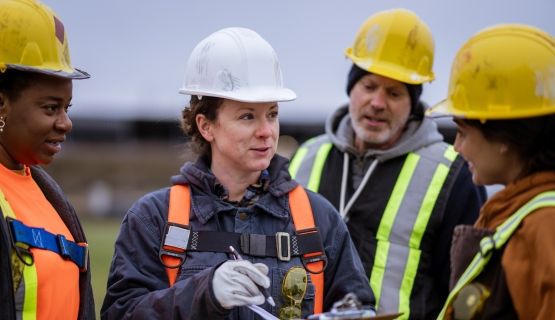Illness/injury prevention
IWH has a long history of conducting research to provide practical guidance to employers, workers, OHS professionals and regulators about what works and what doesn’t in injury or illness prevention. This research targets the injury and illness prevention practices of workplaces, as well as the programs developed by governments, health and safety associations and others to support and motivate workplaces to adopt effective practices.
Featured

At Work article
Differences in firm-level AI use for health and safety
To what extent are Canadian workplaces using artificial intelligence (AI) to help support workers’ health and safety? And what do these workplaces have in common? An IWH study surveyed firms across Ontario and British Columbia to find out.
Published: October 8, 2025

Impact case study
Saskatchewan’s construction safety group uses IWH tool to improve safety culture
This case study details how the Saskatchewan Construction Safety Association (SCSA) members have been analyzing IWH-OPM scores to adjust their safety practices and how SCSA has been using the data to tailor their outreach.
Published: February 10, 2025
IWH Speaker Series
IWH Speaker Series
What can hospital emergency records tell us about the incidence of work-related traumatic injuries in Ontario?
Every year, hospital emergency departments in Ontario treat an average of 100,000 cases of work-related injuries or illnesses. What can the records of these cases tell us about the reporting of work-related injuries and illnesses to Ontario’s Workplace Safety and Insurance Board (WSIB)? In this presentation, Dr. Cameron Mustard shares findings from research comparing WSIB claims data with records of hospital emergency department visits over a fifteen-year period (2004-2017).
Published: June 2021

At Work article
Weaker OHS procedures, policies explain small employers’ higher injury risks: study
Workers at small firms are more exposed to hazards and report more work-related injuries and illnesses. But an IWH study finds injury risks in large and small firms even out when weaker OHS policies at small firms are accounted for.
Published: May 2021

At Work article
Costs of providing UV ray protection at job sites outweighed by averted skin cancers
Ultraviolet radiation due to sun exposure is one of the most common causes of work-related cancer in Ontario. A new study by IWH examines the costs and benefits of providing protective clothing and shade shelter to avert work-related skin cancer over 30 years.
Published: May 2021

IWH in the media
How does unionization make a difference with workplace safety?
The union safety effect is real — at least in Ontario’s major construction sector, writes John Dujay in reporting on research findings from IWH Scientist Dr. Lynda Robson
Published: Canadian HR Reporter, April 2021
Project report
Project report
Improving information on worker health protection in Ontario
This research study had the broad purpose of evaluating records of emergency department visits as a source of information for monitoring work-related injury and illness in Ontario. The primary objective of the study was to conduct a formal record linkage of emergency department records for the treatment of work-related injury and illness and workers’ compensation claims over the period 2004-2017. The main interest of this study is to describe the characteristics of the approximately 50,000 annual emergency department records for the treatment of a work-related injury or illness that do not link to a workers’ compensation claim.
Published: April 2021

Tools and guides
Implementing MSI prevention programs: Advice from workplaces for workplaces
This resource, developed with partners in Newfoundland and Labrador, provides research and practice evidence on musculoskeletal injuries (MSI) prevention practices and programs for workplaces to consider and implement. The resource describes the evidence in three main sections: awareness, training, and hazard identification and solutions.
Published: February 2021

At Work article
Union firms have lower lost-time claim rates, study in ICI construction confirms
Five years ago, an IWH study found lower lost-time injury claim rates in unionized firms in Ontario's industrial, commercial and institutional construction sector. A new study uses more recent data to see if it can replicate the observed "union safety effect."
Published: January 2021
Project report
Project report
Updating a study on the union effect on safety in the ICI construction sector
IWH updated a previous study on the union safety effect in Ontario's industrial, commercial and institutional construction sector. Like the first study, the update found unionization was associated with a lower risk of injuries requiring time away from work, including both musculoskeletal and critical (more severe) injuries.
Published: January 2021
IWH Speaker Series
IWH Speaker Series
The union effect on safety in the ICI construction sector: a study update
A study conducted several years ago by the Institute for Work & Health found unionized companies in Ontario's institutional, commercial and industrial (ICI) construction sector had a lower rate of lost-time injury claims than their non-unionized counterparts, after accounting for other factors like company size. In this presentation, Dr. Lynda Robson shares an update of that study, using data from 2012-2018. She discusses whether the latest results support what's called a "union safety effect", and how findings vary by company size and types of construction work.
Published: January 2021
Project
Project
Understanding OHS motivations and needs in small business
By looking at small businesses engaged with WSIB's Health and Safety Excellence Program, this IWH project is looking for effective approaches to delivering OHS services to small businesses and help them improve their safety cultures and outcomes.
Status: Ongoing